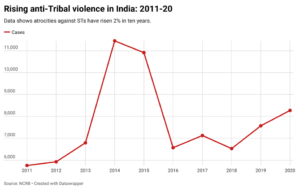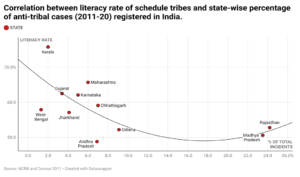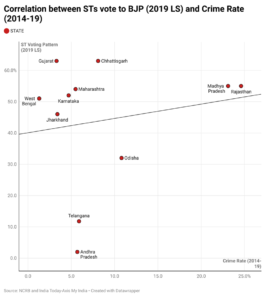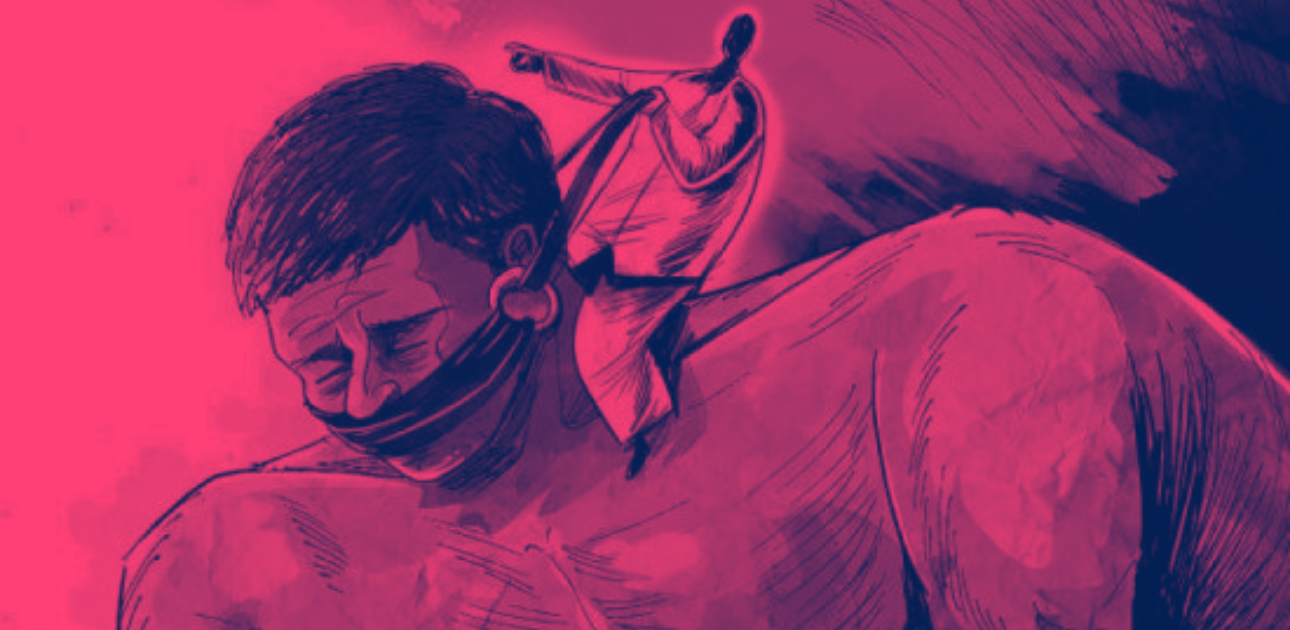There is a huge gap between the democratic ideals which the Indian State proclaims and the lived encounters of adivasis with the State. Adivasis are situated at the margins of society; any kind of systemic violence they face arises from the everyday socio-economic processes of Indian society.
———
THE aboriginal people of India, also known as ‘Adivasis’, had been treated as racially primitive savages by the erstwhile British government. The colonial State employed brute force while dealing with these people, reducing them to primitive savages who comprised the white man’s burden. With the creation of India as a modern State, this intrinsic otherization of tribal people continued. They were viewed as ‘irrational’ and fundamentally incapable of being considered at par with ‘normal’ Indians.
In December 1946, at the Constituent Assembly debates, the leader of Adivasi Mahasabha, Jaipal Singh Munda, openly proclaimed himself as a proud Jungli (forest dweller). Munda argued in the assembly that backwardness is not necessarily an attribute of ‘tribalness’; instead, it is a resultant factor of the centuries of exploitation that have been thrust upon them by non-aboriginals. Even Dalit leader Dr B.R. Ambedkar critiqued the caste system as being primarily responsible for manufacturing the pathetic conditions of primitive tribes and criminal tribes in India.
The concept of tribes gained legal recognition in the Constitution of India. Adivasis were designated as Scheduled Tribes [ST], and offered specific protective provisions, such as the Fifth and Sixth Schedules of the Constitution that provided them a certain level of autonomy. Today, India has 84.3 million ST people (8.2 percent of the population) who are categorized into 461 ethnic tribes and an additional 174 unrecognized tribal groups.
Also read: Pushed to the brink, adivasis march against coal mine expansion in Hasdeo Arand, Chhattisgarh
Rise in crimes against adivasis



However, despite seventy-four years of India’s Independence, the tribal community still suffers from enormous violence across India. The National Crime Records Bureau [NCRB] reports show that in the past ten years (2011-20), 76,899 crimes have been reported to have been committed against STs. As shown in Figure 1, such crimes have been rising at an alarming scale. In 2011, there were 5,756 such crimes reported, and by 2020, the figure reached 8,272. These are, it must be kept in mind, just the registered cases of violence; the unregistered cases are bound to be much more than what data shows.
Figure 2: Map spotting state-wise comparison of crimes against STs: 2011-20.
A state-wise comparison of anti-tribal violence is crucial to understanding the scale and causes for this violence. In every state, tribals are oppressed in different ways. In Madhya Pradesh, the prostitution rings exploit the tribals while in Jharkhand and Chhattisgarh, counter-insurgency operations against Maoists regularly victimize the tribals living there. Figure 2 shows that anti-tribal violence is concentrated in the states of Rajasthan, Madhya Pradesh, Odisha, Chhattisgarh and Andhra Pradesh. Most of the tribes are concentrated in these states. However, the reason for such violence differs from state to state. In general, tribals are situated at the margins of society; thus, any kind of systemic violence they face arises from the everyday socio-economic processes of Indian society.
The NCRB data, it must be kept in mind, reveals just the registered cases of violence; the unregistered cases are bound to be much more than what data shows.
The State, in general, plays a significant role in committing violence on tribals in India. In July 2021, the forest department in Madhya Pradesh summarily evicted dwellings of Bhil and Barela communities, and there have been cases where the tribals have been displaced from Chhattisgarh to Andhra Pradesh due to public-private partnership projects. Several tribal communities across the country are still fighting for rights to their lands. In a study, the data research agency Land Conflict Watch explained that among 703 ongoing conflicts across India, 25 per cent are in tribal areas alone. The scholar Sanjukta Das Gupta elaborated that this phenomenon has been coming into national prominence from the 1990s onwards due to recurring land rights encroachment on tribal land, both by the State and corporate groups.
NCRB’s data only shows violence against STs; there are also ‘denotified tribes’ that have not been accounted for in NCRB’s data set. The violence enforced on nomadic tribes is also a worrisome issue. The Free Press Journal reported that, in May 2019, women belonging to denotified tribes testified that they were tortured and raped almost every day. Denotified tribes are not scheduled, so they lack legislative protection, making them even more vulnerable.
The rising rape cases against tribal women is another significant marker of enforced patriarchal violence. States such as Madhya Pradesh, Chhattisgarh, Rajasthan and Maharashtra have poor records pertaining to sexual violence against tribal women. Rape or various other forms of sexual violence are used as a tool to show women their place in society; tribal women are much more prone to sexual violence as they are considered ‘less than human’ by the majority of Indians. In June last year, a teenage tribal girl in Chhattisgarh was allegedly raped and killed in a staged encounter by the members of security forces.
Scholar Kriti Sharma explains that gender-based violence is primarily shaped by the ongoing colonization, militarism, racism, and social exclusion of Adivasis. She points out that there is a connection between individual gender violence and deprivation of the collective rights of Adivasi women. Hence, the colonial State apparatus is a medium to enforce neo-liberal aggression and governmentality on Adivasis, which furthers their mental and physical distress.
The question arises, why does violence against the tribal community keep on rising?
The colonial State apparatus is a medium to enforce neo-liberal aggression and governmentality on Adivasis, which furthers their mental and physical distress.
Also read: “We are children of the forest”: Our journey as Adivasi Lawyers
Factors behind surge in crimes against adivasis
There are numerous factors involved in this violence. One such factor is the ease with which perpetrators get acquittal in most such cases. The conviction rate for offences under the Scheduled Castes and Scheduled Tribes (Prevention of Atrocities) Act against adivasis was 22.8 per cent between 2009 and 2018, even when such cases rose by 575.33 per cent in that period. There have been incidents where victims have become hostile, and in some cases of sexual violence, victims have been forced to retract the case due to external pressure. Such incidents prove how the Indian State and society are complicit in the violence against tribals. This also causes adivasis also start losing faith in the justice mechanism.
The other indicator is the caste-based distribution of resources. In India, it is the upper caste that has a greater hold over material resources, and the Adivasis and Dalits lack power over resources, which makes them vulnerable to economic and social exclusion. A World Bank report shows almost 43.8 per cent of the ST population in India lived below the poverty line as of 2004-05. It also shows that adivasis constituted 25 percent of the poorest decile of India's population in 2004-05, in spite of constituting eight per cent of the total population. In comparison to the 1980s and 2004-05, the Adivasis lag behind by twenty years when it comes to development ratio. The poor socio-economic indicators of the STs means that they are systematically subject to a continuous cycle of violence.
This also bears the question over how much role the State plays in perpetuating violence in the lives of Adivasis.
South African scholar Alf Gunvald Nilsen argues that in the context of western Madhya Pradesh, government functionaries who are supposed to provide citizenry rights and services to adivasi people are not fair. There is a huge gap between the democratic ideals which the Indian State proclaims and the lived encounters of adivasis with the State. Tribals experience the State’s presence in their lives as everyday tyranny in the form of forest guards, security forces and revenue officials, among others, who treat them as inhuman subjects. For instance, in 2010 in Gujaarat, forest guards had assaulted tribals of the Kunbi community for merely cultivating on reserved forest land in Gujarat, and just last month, forest employees had been caught taking bribes from tribals in Madhya Pradesh. Nilsen says, “This is an everyday spiral of tyranny tribals have to suffer in their daily lives.”
The global tribal rights organization, the International Work Group for Indigenous Affairs explains that despite a plethora of laws protecting tribals present in India, they remain largely ineffective on the ground. It also said that NCRB does not record the human rights violations committed against them by security forces.
Tribals experience the State’s presence in their lives as everyday tyranny in the form of forest guards, security forces and revenue officials, among others, who treat them as inhuman subjects.
The United Nations [UN] Human Rights Council’s Universal Periodic Review 2016 describes India’s position on the recognition of the indigenous population as paradoxical in terms of policy and practice. Though India voted in favor of the UN Declaration on the Rights of Indigenous People in 2007, it continues to deny the concept of ‘indigenous population’, and claims that all Indians are indigenous. This paradoxical positioning of India on this matter on international platforms shows how the discriminatory nature of anti-tribal violence is subsumed by defining all Indians as indigenous.



Figure 3 shows that in almost all states, an increase in tribal literacy leads to increased violence against them. States which rank both high and low on the literacy scale display this positive correlation between violence and literacy rate. This observation seems counter-intuitive. Increased literacy rate intuitively points to upward mobility and making a group less prone to violence. However, this is not the case as both violence and progress are spatially determined.
Increased literacy in tribal areas usually threatens the relative hegemony of the dominant castes in that space. This leads to violence against the tribal people who dared to become equals. Scholar Nandini Sundar argues that large-scale structural injustice and the advent of environmental degradation are significant hurdles to achieve tribal literacy, and the State fails to question the larger inequalities that are responsible for the poverty of adivasis which culminates in violence.
One of the major challenges for the State is to give an equitable share of space to tribals in knowledge formations because it is the tribal community that has mostly been non-existent from the prevailing discourse on any subject in State or society. Hence, it is important to include adivasis through a just mechanism of inclusive education that does not look at them as an 'other,' but as a humanized cohesive whole.
Political angle



A large chunk of the rising crimes against STs has happened under the Bharatiya Janta Party [BJP]-ruled union government. How much does it affect the ruling party’s vote share among STs? Figure 4 shows that there is a positive correlation between the crime rate between 2014 and 2019, and the voting pattern of STs who voted for BJP in the 2019 Lok Sabha polls. The India Today-Axis my India post-poll study shows Gujarat, Chhattisgarh, Madhya Pradesh and Rajasthan, which account for significant anti-Tribal violence, have also seen a higher percentage of votes of STs to the BJP. The rising anti-tribal crimes, it seems, did not affect the electoral credibility of the BJP in 2019.
India continues to deny the concept of ‘indigenous population’, and claims that all Indians are indigenous. This paradoxical positioning of India on this matter on international platforms shows how the discriminatory nature of anti-tribal violence is subsumed by defining all Indians as indigenous.
Scholar K.C. Suri’s analysis of ‘The National Election Survey’ data shows BJP's voting percentage among STs from 1996 (21 per cent) through 2014 (37 per cent) till 2019 (44 per cent) has been gradually rising. The 2019 Lok Sabha election was hotly-contested, and BJP consolidated votes not only among STs but also among rural voters and upper Other Backward Classes, which crucially tilted the elections in their favor. There are other factors at play, such as the media's overt favoritism towards BJP and the role of social media before elections that helped the BJP shift the discourse away from tribal politics towards homogenized nationalist politics that integrates STs and conveniently veils their historical trajectory of oppression.
In the past few decades, it has been noticed that the Rashtriya Swayamsevak Sangh [RSS], a nationalist right-wing volunteer organization that serves as the BJP’s ideological fountainhead, has been engaged in the process of Hinduizing the tribals in central and north-eastern India. They have successfully opened schools and welfare centers such as the Vanvasi Kalyan Ashram, the Sewa Bharati, and the Ekal Vidyalaya that proclaim to work for the upliftment and development of the tribals. However, author and activist Prakash Louis explains that such RSS affiliated groups have been working in Jharkhand and Chattisgarh and have managed to create a rift between the Christian tribals and Hindu tribals from the early 1990s itself.
The smaller business communities are usually mobilized by the RSS under the umbrella term ‘Vananchal’, which then exploit tribal groups to counter Christian adivasis. Louis elaborates further that the BJP has benefitted from this movement and entered into the political fray in the 1990s in Jharkhand. A large number of RSS-backed tribal welfare organizations helped the BJP consolidate its vote bank by communalizing issues. This trend has moved eastwards till Nagaland and Assam too.
Large-scale structural injustice and the advent of environmental degradation are significant hurdles to achieve tribal literacy, and the State fails to question the larger inequalities that are responsible for the poverty of adivasis which culminates in violence.
Also read: Has Congress Reneged on its Promise of Securing Adivasi Rights in Chhattisgarh?
Adivasis have been suffering due to violence for centuries, and it becomes even more important today to look at anti-tribal crimes in isolation from such anti-Dalit incidents. The Dalits in India have been segregated socially and ritually and from upper caste groups, whereas Adivasis have mostly remained in distant proximity from the mainlanders that makes them prone to physical and social exclusion.
(The views expressed are personal.)


